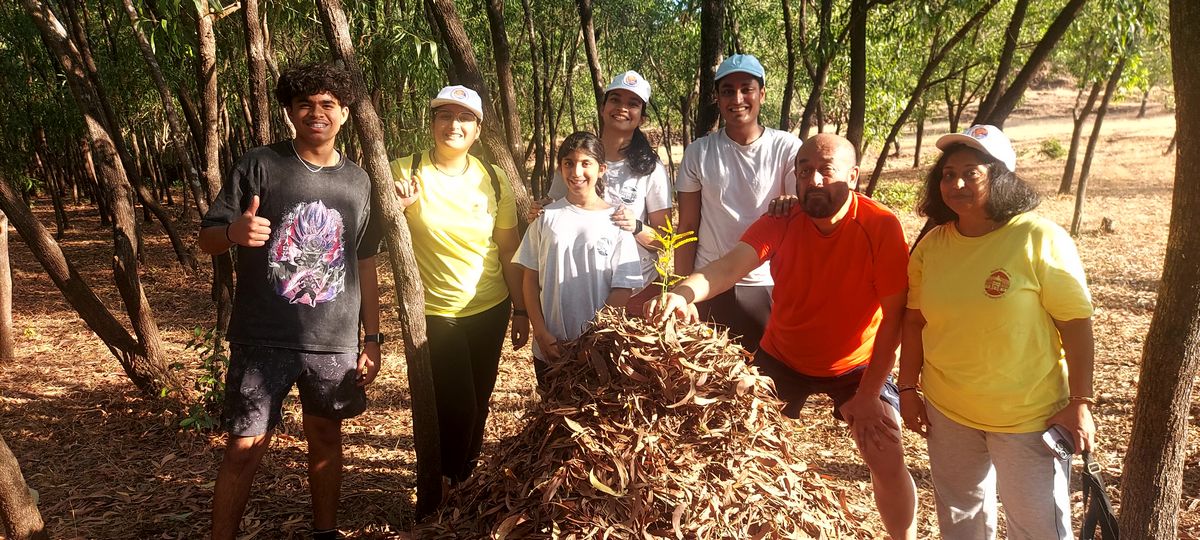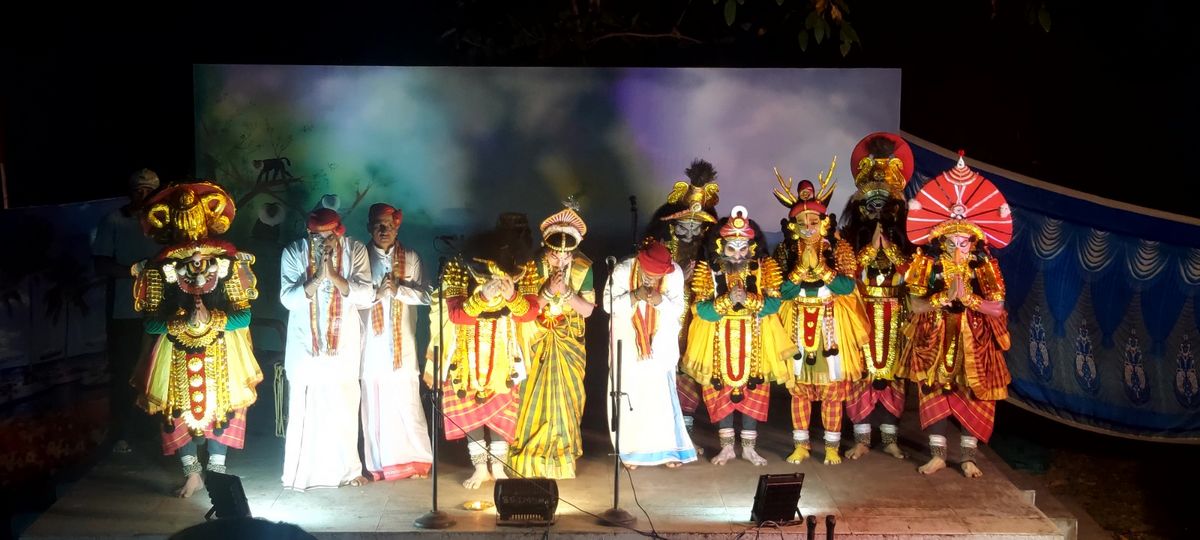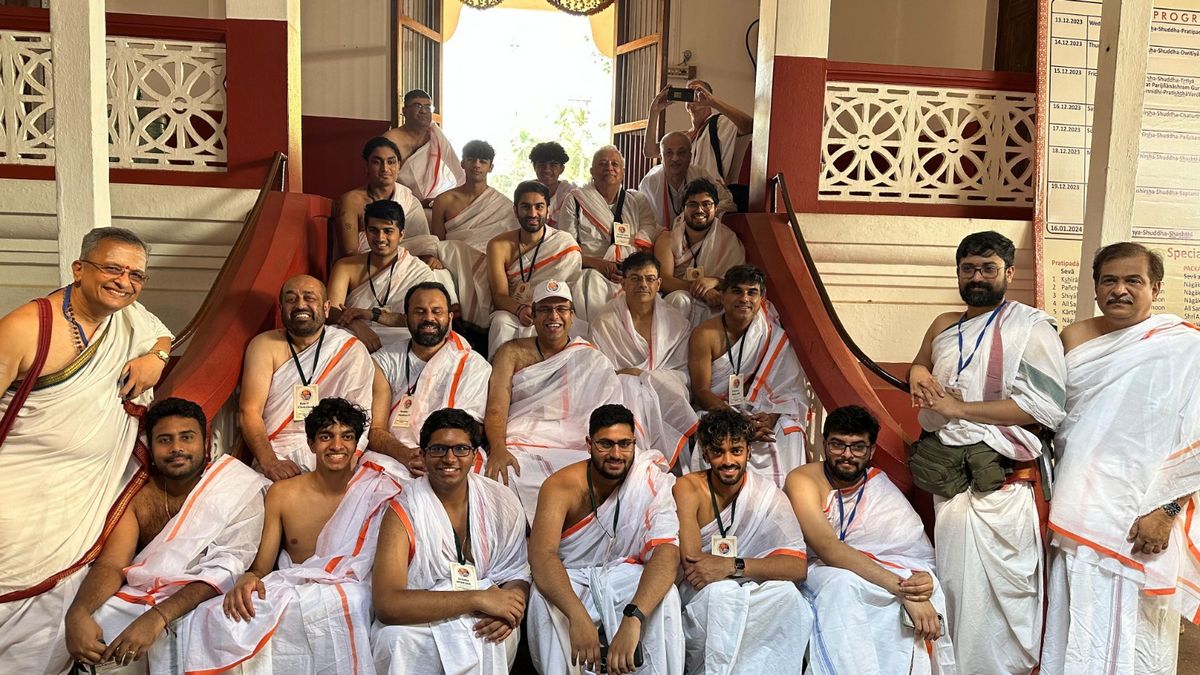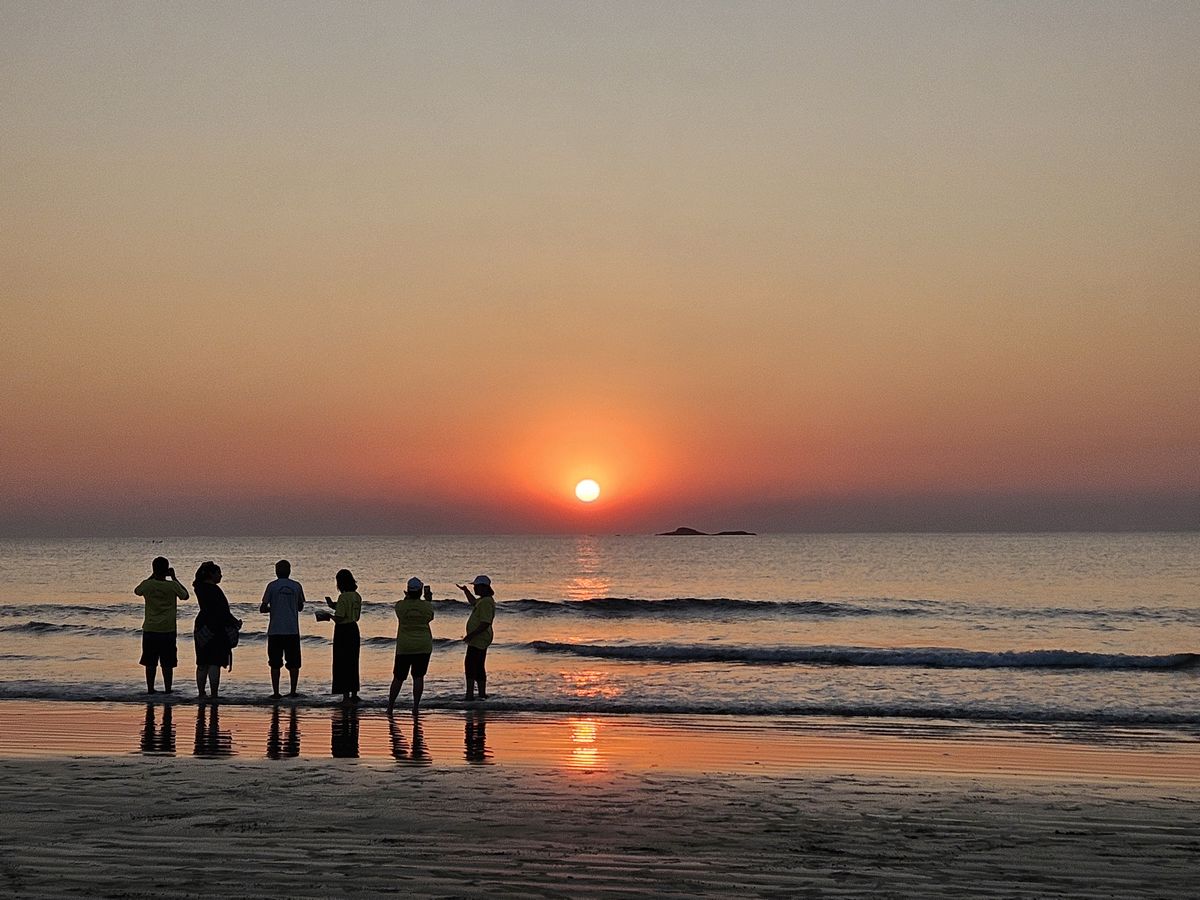Samskriti Parichaya Yatra Shibir 2023
Report by Alpanā Sajīp (UK) and Mallikā Gokarṇ (Singapore)
The Saṁskṛti Parichaya Yātrā (NRI shibir) of December 2023 had fifty-one shibirārthī-s who had flown in from all over the world including the US, Canada, the UK and Singapore. The NRI coordinators were pleasantly surprised that so many people wanted to experience this cultural heritage trip, and there was much excitement and anticipation ahead of our travels.
Many of us had come to reconnect with and understand our roots as Chitrāpur Sāraswat-s, be in the Divine presence of our Beloved H.H. Shrīmat Sadyojāt Shaṅkarāshram Swāmījī, as well as to connect with other NRI Āmchī-s from across the world and build lasting connections. The shibirārthī-s ranged from 12 to 79 years of age with a packed schedule planned across Maṅgal̄ūru, Shirālī and Honnāvar, with day trips to other locations like Mallāpur and Gokarṇa. There were four verticals around which organisers planned the yātrā: religious/spiritual, Mat͟h activities, culture, and nature.
We assembled in Maṅgal̄ūru on the 22nd of December and were warmly greeted by the many sañchālaka-s who had volunteered their time to guide us through the trip, led by Kris͟hṇānand (Kuṭṭy) Hebl̄ekar mām and Prīti Pāṇemaṅgl̄or pāchī. We visited 4 of our Chitrāpur Mat͟h-s in Maṅgal̄ūru, Shirālī, Gokarṇa (including the Toggu Mat͟h), and Mallāpur, and partook in bhajana sevā and prasāda bhojana at all the Mat͟h-s. We also managed to visit temples of pivotal importance to the Chitrāpur Heritage including Shrī Umāmaheshwara Devasthānam in Maṅgal̄ūru, Shrīmath Anantheshwar Temple at Viṭṭlā, as well as Shrī Paṭṭa Vināyaka Temple and Koṭi-tīrtha at Gokarṇa. Our visits to the Mat͟h-s and temples were that much more impactful thanks to the enlightening presentations given by Dharmaprachāraka- Dr. Chaitanya Gulvāḍy mām and Jyothi Divgī pāchī on the history and migration of Chitrāpur Sāraswat-s from the banks of the Saraswatī river in the Kashmīr-Haryāṇā region, to their arrival in Goā and being driven out by Portuguese invaders, to eventually settle across northern and southern Kănarā. Many of us were amazed by the richness of a history we had not previously known and the presentations were accompanied by many pictures of locations along these routes, to bring the journeys of migration to life.
Our trip coincided with the Datta Jayantī festival on 26th December, and we were blessed to have been present at Shirālī with our Pūjya Swāmījī to participate in the Gurupūjana on the auspicious occasion as well as offer Bhiks͟hā sevā and Shrī Pādukā Pūjana (a first for many of us). On the auspicious occasion of Datta Jayantī a number of developments and new initiatives were announced by Praveeṇ Kaḍl̄e mām, including a major expansion of the site where Ganapati English Medium High School (GEMS) is currently located. We were humbled and privileged to have been able to visit both the GEMS campus in Maṅgal̄ūru and Srivali High School in Shirālī. The students in Maṅgal̄ūru presented a thought-provoking drama on the ‘Role of Time’, among other performances. The students at Srivali High School recited a portion of the Shrīmadbhagawadgītā and left us all in a state of awe at their ability to chant completely in unison and connect to each other in a deeply spiritual way.
Under H.H. Swāmījī’s Guidance, a number of women empowerment schemes are underway to uplift society in the areas around our Mat͟h-s. During the course of our yātrā we had on-site visits to almost all of these initiatives. We started with Shrī Parijñānāshram Handmade Paper Unit at Kembre, and guided by Laks͟hmī Shiroor pāchī, we experienced first-hand, the processes employed and learned about the skills and resources needed to produce the paper used for creating products like notebooks and bags. Next was Saṁvit Sudhā where we saw some of the ladies in action, being trained in screen-printing and block printing, and we were guided through this experience by Vinatī Udiyāvar pāchī. Last but not the least was a visit to one of the Self-Help Groups under the Parimochana project, which we were introduced to by Sheelā Kumbl̄e pāchī. We were given the opportunity to interact with the beneficiaries, to touch and feel the delightful products they are creating, and to learn from them how to weave Bhaṭkal̄ Mogrā flowers into intricate garlands - a much harder task than what it seemed like at their skillful hands.
The shibirārthī-s were also guided through the Kembre farms where we saw fresh produce being grown and ate some spicy fresh peppers. Gaurīsh Paḍukoṇe mām took us through the Goshālā and told us of the work being put in to breed out the non-Indian breeds of cows. We were keen to participate in kara-sevā as well and were put to work raking the leaves in a section of the farmland. We felt it was important to make as much of an impact as possible in the limited time we had, and so a little friendly competition went a long way when seeing which group could make the largest pile of leaves!
Being introduced to the natural ecosystem of the north Kănarā region was a treat. Nature has the power to renew and refresh, but also teaches important life lessons through direct interaction. We visited Al̄vekoḍi beach, Maravanthe beach, Tannirbhāvi beach, Sharāvathi Kaṇḍlā Mangrove boardwalk, and Gersappe forest. Our games of kho-kho at Al̄vekoḍī beach, walking along the shallows and observing the beautiful starfish and crabs, the ethereal sunset we witnessed in the presence of H.H. Swāmījī, and the sunrise trek through Gersappe forest gave us the time to connect, introspect and create life-long memories. The time at Gersappe was an outstanding feature of the yātrā as we were keen to catch a glimpse of the endangered Lion-tailed Macaque (LTMs). The volunteer team at Gersappe fed us delectable seasonal and local festival food at every meal, while Mr. Vasanth Reḍḍy of the Indian Forest Service (IFS) and Praveeṇ Basrūr mām briefed us on the ecology of the forest and how the IFS is working to preserve biodiversity by combating human encroachment in areas of environmental significance. We learned that this is an area of almost unparalleled biodiversity, not just in India but in the world, with innumerable species of insect, animal and plant life, including a rare species of cashew of which only 100 trees exist in the world. It was impressive and moving to see how much work Mr. Reḍḍy and his team have put into this ongoing project and it gave many of us hope to see that this kind of conservation is not only possible but is actively happening in India.
Praveeṇ mām generously shared what he knew about the Lion-Tailed Macaques (LTMs) in the forest sanctuary, including how intricately their communities operate – we learned about the delicate balance of personalities within LTM communities, and also that LTMs are loyal creatures who choose only one partner in their lives, even if their partner dies or they are separated early. We also observed how humans have, to mitigate the sometimes-disruptive effects of development, helped the LTMs to thrive, such as by building natural bridges across the treetops so that LTMs aren’t forced to cross dangerous roads.
At Gersappe, many of us were excited to watch a performance of Yaks͟hagāna, the traditional folk dance-drama performed across Karnāṭaka, by Guru Hegḍe’s troupe from Guṇavante, Honnāvar. Traditionally Yaks͟hagāna performances run from dusk till dawn, but given our hectic schedule, the troupe put on a shorter performance for us in the late evening. We marvelled at the impressive costumes and dramatic makeup, and even those of us who could not understand Kannaḍa were able to glean some details of the exciting portrayal of “Sītā Haraṇa”. As Āmchī-s it is natural for us to have an appreciation for, and affinity with the arts, so the shibirārthī-s were happy to present a talent show including dances (Dāṇḍiyā, Kathak, Bharatnāṭyam and Oḍissī), music (tablā solo) and songs (fusion bhajana-s, a duet and a Koṅkaṇī version of ABBA’s “Thank you for the music”). Finally, the yuvā-s and volunteers presented a medley of songs, a Bharatanāṭyam dance and a skit on the mannerisms of our beloved sañchālaka-s which ended with the sañchālaka-s being brought on stage for a tongue-in-cheek ‘muṇḍū dance’.
Through all of these exciting events, the highlights were the interactions that we had with Pūjya Swāmījī. We had many occasions to be in His divine presence, such as during the Dīpa-Prajvālana, Datta Jayantī Dharma sabhā, as well as informal sessions in the Dhyāna Mandir, at Al̄vekoḍi beach, and our trek to the Jain Basadi ruins of Rānī Chennabhairādevī’s (the Pepper Queen’s) fort. A number of the shibirārthī-s also took mantra-dīks͟hā during this trip and H.H. Swāmījī met each one with grace, complete attention, interest and care; each came away from these meetings feeling a more personal connection and a fulfilment at having the opportunity to discuss their questions and worries. The sessions where all shibirārthī-s were in interaction with H.H. Swāmījī were heavily peppered with words of wisdom for each of us to bring back to our daily lives.
This yātrā has become an irreplaceable memory that will have an immeasurable impact on all our lives. We left with a sense of gratitude to our Gurushakti for instilling strength in us and steering us in the right direction. In these 8 days, we experienced and learnt about many different aspects of our Mat͟h, our way of life, and our history. We return home now, sad to leave each other, with promises to strengthen our ties even more; some action on this has already begun in the form of online classes to continue our studies of prāṇāyāma and Sanskrit. From forging new friendships to establishing a deeper understanding of our roots, as well as connecting with our puṇya-bhūmi and our Beloved Swāmījī, we have etched memories into our minds that will last a lifetime











